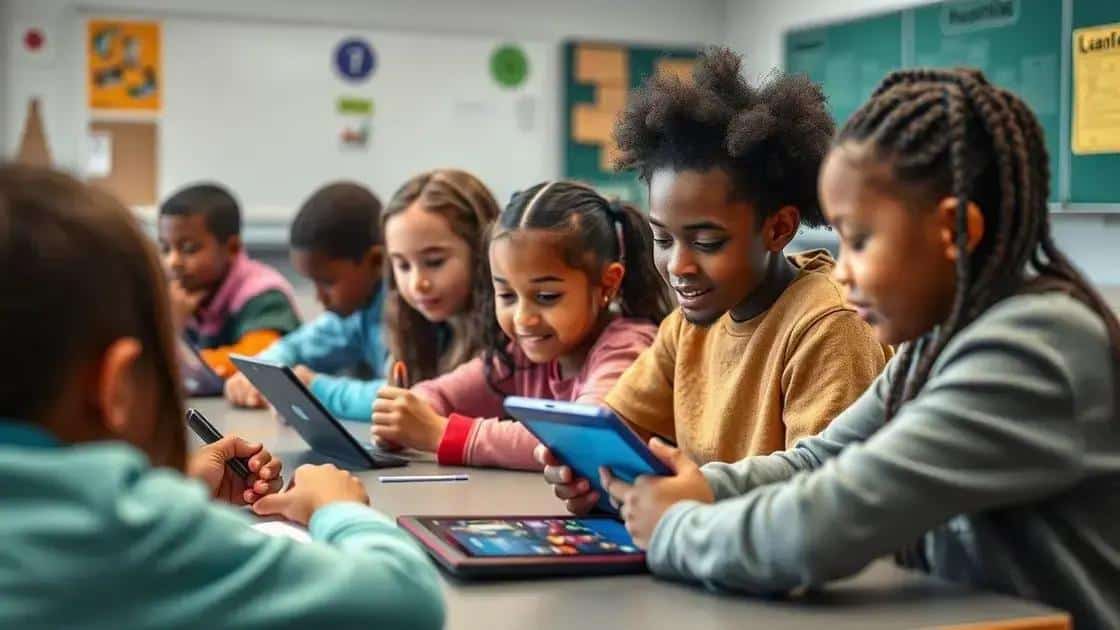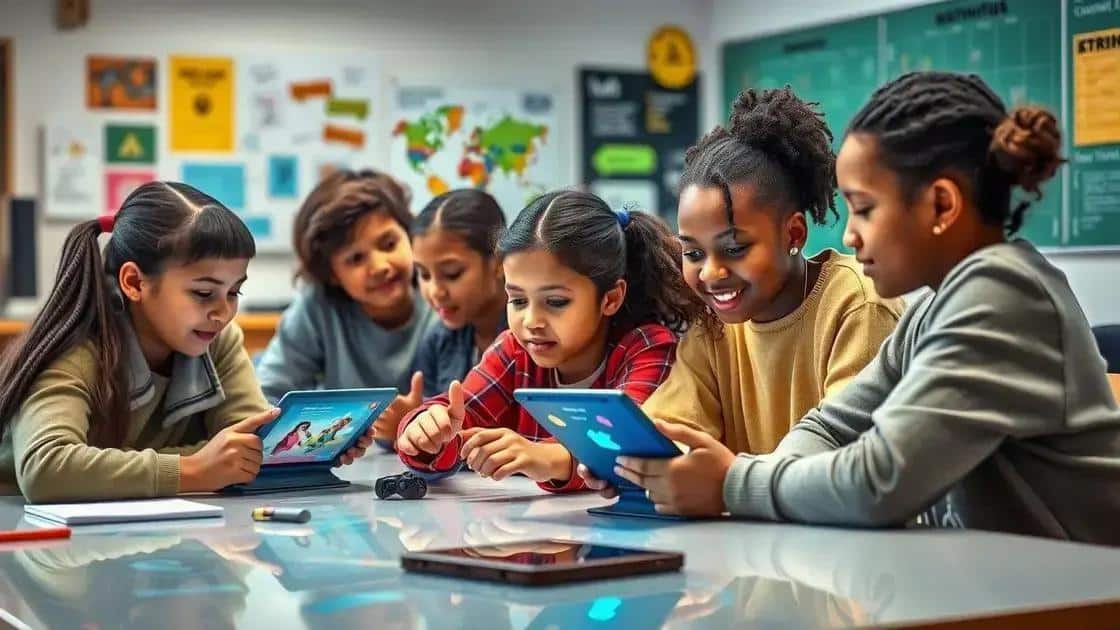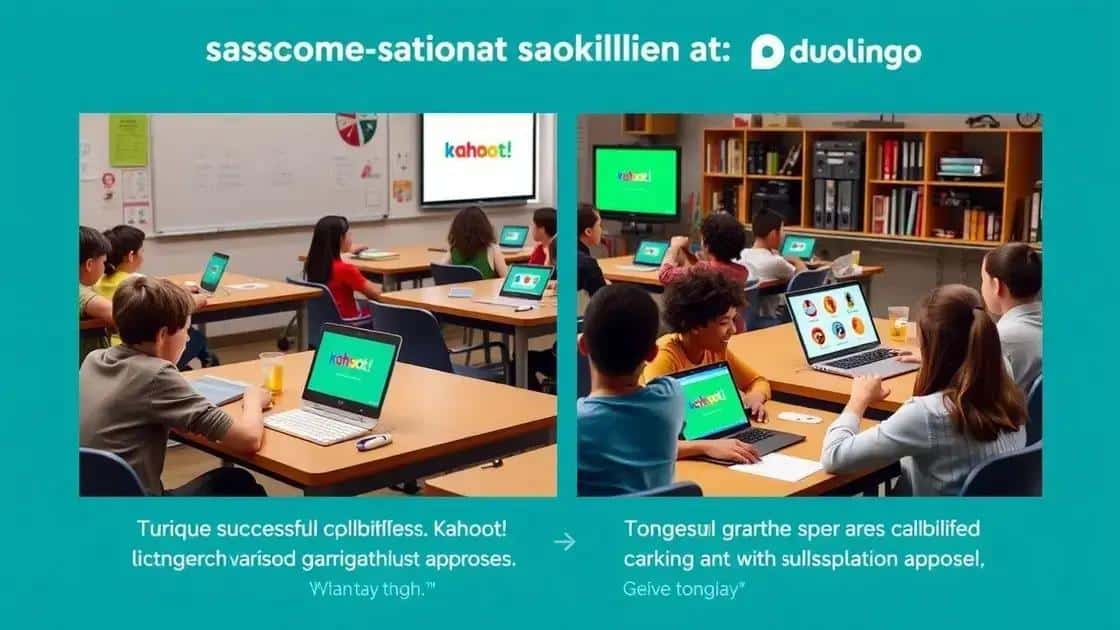Gamified learning platforms trends shaping education

Gamified learning platforms enhance education by using game elements to increase student engagement, motivation, and retention, as evidenced by successful examples like Kahoot! and Duolingo.
Gamified learning platforms trends are shaking up traditional education by making learning more interactive and fun. Have you ever wondered how these innovations can make a difference in your classroom or training sessions? Let’s dive into it!
Understanding gamified learning platforms
Understanding gamified learning platforms is essential in today’s educational landscape. These platforms combine game elements with traditional learning to create engaging experiences. Let’s explore what they are and why they matter.
Key Features of Gamified Learning Platforms
Gamified platforms use various features to enhance the learning process. These elements create an environment where students are motivated and interested.
- Points and Rewards: Students earn points for completing tasks, making learning feel like a game.
- Leaderboards: Friendly competition encourages learners to improve their skills.
- Challenges and Quests: Tasks are structured as quests, making them more exciting.
- Feedback: Instant feedback helps learners know how they’re doing.
This gamification approach not only makes learning fun but also fosters retention. The idea is to blend educational content with game-like engagement. Another key aspect is the ability to track progress, which is vital for both learners and educators. By understanding how students interact with the platform, educators can tailor lessons to fit their needs.
Another important feature includes customization options, which allow users to personalize their learning experience. This flexibility keeps learners invested in their journey. By incorporating elements of storytelling, gamified platforms can immerse learners in scenarios that encourage critical thinking and problem-solving skills.
Benefits of Gamified Learning
The benefits of using these platforms are clear. They not only enhance motivation but also improve learning outcomes. Regular engagement leads to better information retention.
- Improved Engagement: Gamification grabs students’ attention effectively.
- Increased Motivation: Fun elements inspire students to participate actively.
- Better Retention: Learning through games can lead to stronger recall.
Gamified learning platforms also cater to various learning styles, making them inclusive. The interactive nature appeals to visual, auditory, and kinesthetic learners alike. As a result, these platforms are becoming increasingly popular in classrooms and training programs around the world, transforming education into something exciting and dynamic.
Benefits of gamified approaches in education

Benefits of gamified approaches in education are numerous and impactful. These innovative strategies enhance student engagement and boost learning outcomes, making education not only informative but also enjoyable.
Enhanced Engagement
One primary benefit is the increase in student engagement levels. Gamified learning turns traditional lessons into interactive experiences. Students are more likely to participate actively when they feel they are playing a game rather than simply studying.
- Interactive Content: Activities are hands-on and involve various media.
- Active Participation: Lessons encourage students to take part rather than passively listen.
- Community Building: Collaborative challenges foster a sense of community among learners.
Another significant advantage is improved motivation. When students earn rewards and points, their drive to achieve grows. They feel invested in their learning process. This motivation not only encourages students to complete tasks but also to strive for excellence.
Improved Retention and Learning Outcomes
Gamified approaches can also lead to better retention of information. Learning through games and interactive content helps engrain concepts in students’ minds more effectively. This method makes revisiting learned material easier and more enjoyable.
- Memory Retention: Enjoyable learning experiences stick better.
- Problem-Solving Skills: Games often require critical thinking.
- Real-Time Feedback: Instant responses encourage students to adapt and improve.
The flexible nature of gamified platforms accommodates different learning styles. Visual learners benefit from graphics, while kinesthetic learners engage in hands-on activities. This inclusivity ensures that all students can thrive in a gamified environment. As education continues to evolve, gamification is set to play a major role in shaping how students learn and interact with the material around them.
Emerging trends in educational gamification
Emerging trends in educational gamification are shaping the future of learning. As technology advances, educators are finding innovative ways to engage students through gamified experiences.
Increased Use of Virtual Reality
One of the most exciting trends is the integration of virtual reality (VR) in classrooms. VR allows students to experience learning in immersive environments. Students can explore historical sites, dive into oceans, or even travel through space, all from their desks.
- Immersive Learning: Engages multiple senses for deeper understanding.
- Interactive Experiences: Students participate actively in their learning journey.
- Real-World Applications: Programs simulate real-life scenarios for practical learning.
This technology not only makes lessons more engaging but also creates memorable learning moments. The combination of gamification and VR is setting new standards in education.
Personalized Learning Paths
Another trend is the development of personalized learning paths. These paths allow students to learn at their own pace. By using data from student interactions, platforms can adapt content and challenges to meet individual needs. This approach fosters a tailored learning experience, ensuring that every student thrives.
- Data-Driven Insights: Teachers can track progress and identify areas for improvement.
- Flexible Learning: Students choose learning activities that resonate with them.
- Engagement: Personalized challenges increase motivation and participation.
This trend emphasizes that no two learners are the same, making education more inclusive. As educators embrace these advancements, the traditional classroom is transforming. Incorporating elements like social collaboration and cross-platform integration is also becoming common.
Students are increasingly engaging in team-based challenges where they can collaborate with peers worldwide, combining learning with fun. This shift not only enhances global understanding but also builds essential teamwork skills. Overall, these emerging trends in educational gamification promise to create a more dynamic and effective learning environment for future generations.
Case studies of successful gamified platforms

Case studies of successful gamified platforms showcase the effectiveness of this approach in various educational settings. Many institutions are adopting gamification to improve learning outcomes and student engagement.
Kahoot!
Kahoot! is a popular game-based learning platform used in classrooms worldwide. It allows teachers to create quizzes that students can answer in real-time, transforming the learning experience.
- Real-Time Engagement: Students compete against each other, increasing motivation.
- Immediate Feedback: Scores are displayed instantly, making it exciting.
- Accessibility: Available on various devices, making it easy for all students to participate.
This platform has shown significant improvements in student participation and knowledge retention. Teachers report that students are more enthusiastic about learning when gamification is involved.
Duolingo
Another successful case is Duolingo, which gamifies language learning through bite-sized lessons and interactive elements. Users earn points and can track their progress, making the learning process engaging.
- Daily Goals: Users set daily learning goals to stay motivated.
- Levels and Rewards: Progression through levels keeps learners challenged.
- Community Engagement: Learners can engage with others, enhancing their experience.
Duolingo’s approach has led to millions of users around the globe, highlighting how gamified elements can make learning a new language enjoyable and effective.
A more localized example is Classcraft, a platform that turns the classroom into an RPG (role-playing game). Teachers can create quests that align with their curriculum, allowing students to earn experience points for positive behavior and academic achievements. This method encourages collaboration and teamwork among students.
These case studies illustrate that successful gamified platforms not only increase student engagement but also foster a more collaborative and motivating learning environment. As educational institutions continue to adopt these techniques, we can expect even more innovative solutions in the future.
FAQ – Frequently Asked Questions about Gamified Learning Platforms
What are gamified learning platforms?
Gamified learning platforms use game elements to make education more engaging and interactive, enhancing student motivation and participation.
How do gamified platforms improve learning outcomes?
By incorporating rewards, challenges, and competition, gamified platforms boost student engagement and help with information retention.
Can gamification be used for all age groups?
Yes, gamification can be adapted to suit various age groups and learning styles, making it effective for both children and adults.
What are some examples of successful gamified platforms?
Examples include Kahoot! for quiz-based learning and Duolingo for language learning, both of which have shown increased student engagement and motivation.






